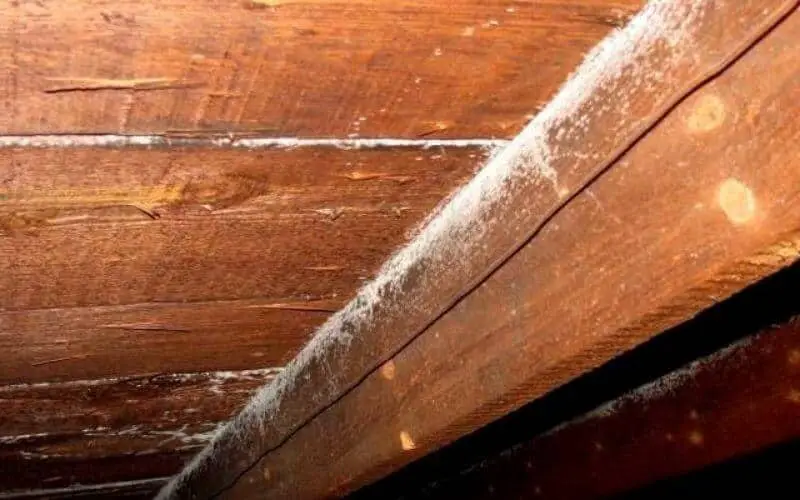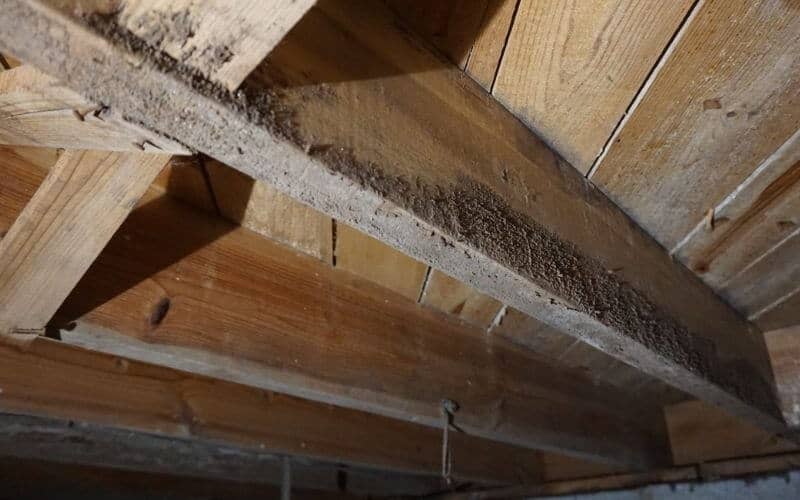If you live in a humid region, you must have noticed the growth of mold in different areas of your home, but the floor joists in crawl places are usually more susceptible to mold growth, this is mostly due to its location.
Mold growth in joists can sometimes become severe and problematic and can only be handled by professionals.
But if the mold spores are still in the earliest stages of development, here’s how to get rid of mold on floor joists in crawl space effectively.
Crawl spaces are usually less expensive than basements and provide a great alternative to accessing the bottom of a home, especially in regions with dry climates. But it collects moisture easily and becomes a breeding ground for mold.
Read: Best mold and mildew resistant powder
How to Get Rid Of Mold On Floor Joists In Crawl Space
Table of Contents
Using Water and Vinegar Mixture
Create a cleaning solution in a spray bottle by mixing 10 parts water and one part white vinegar or liquid bleach.
When making use of bleach, ensure to get a suitable spray bottle that will allow you to pour the solution easily without spilling, to prevent the damage of clothes or other belongings.
Also wear a respirator mask and ensure your work area is properly ventilated by opening any window or doors while using the bleach.
Use An Anti-Mold Solution
There are different anti-mold products available in the market. Simply select the product and choice and apply accordingly to the manufacturer’s instructions.
They are usually available in a spray bottle, so simply adjust the spray function to a mist setting and douse the mold spores; do not use a forceful stream of water to remove the mold spores to avoid splashing them everywhere.
Place the spray bottle inches away from the affected area before spraying for an effective application, you may need a ladder to reach higher levels of joists when working in your basement.
To prevent the solution or mold spores from dripping on you, try to avoid spraying the solution directly over your head. You also need to wear safety glasses and observe proper precautions.
Read: Best mold foggers review
Clean the Sprayed Area
Clean the area you applied the solvent using a clean and absorbent rag. If the mold spores are spread over different areas on the floor joists, use a clean rag for each new area, this will help to prevent the spread of the spores.
When you are done, wrap up the used rags in a plastic bag and properly dispose of them.
Read: How to dry water under wood
Apply More Solution
After wiping the mold spills after the first application of the solution, apply the solution you are using the second time and allow it to sit for 24 hours. Mold is a resilient microorganism so do not neglect it, else it will resurface.
Repeat the application process; spraying the solution and wiping the area for at least three consecutive times and allow them to sit for 24-hour each time.
After the third application, wait for a week before repeating the entire process for another three days. Remember to discard the used rags properly each time.
Read: How to waterproof wood floor
Ensure The Crawl Space Is Well Lit
When working in a crawl space you may find that the lighting is quite dim, you can take an extension cord and a drop light in the area as you inspect the floor joists for mold.
Get a helping hand if you can, this will make it safer and easier as the person can direct the light while you spray and wipe, this allows you to focus and do a more thorough and better job.
How to Tell If Your Floor Joists Has Been Infected With Mold
Mold spreads very quickly when it starts growing, this is why it is very important to know what it looks like, infected areas, and how to negate their growth.
There are over 100 species of mold with different possible warning signs of an infestation. Here is how to tell if your floor joists have been infected with mold.
Read: What does mold smell like?
Musty Odor
A musty and damp odor is usually the first tale sign of the infestation of mold. As the spores grow into a large colony, the damp and musty smell develops. You will probably detect this smell first before you can see the growth.
You can notice the musty smell from the crawl space inside the house or around the vents or entryway to the area beneath the house. The musty smell of mold is sometimes impossible to hide even if you use fresheners.
Problems With Your HVAC System
When there’s a mold infestation in the crawl space of your home it may also spread into the HVAC system. When it does, it can travel up through the air ducts of the home, and fill the house with its musty odor and deposit its spores in different areas which leads to the infestation of more areas.
Structural Damage
Your home is made from organic materials which is a source of life for mold. When mold infects your crawl space it may lead to the deterioration of wood, paper, fabrics, or glue as the colony of mold grows and spreads.
Mold can cause a great amount of damage to the supports and materials of the crawl space which can have a negative impact on the safety and structural integrity of your home.
As mold growth spreads across the floor joists or up into the floorboards, it could cause floors to crack, the ceilings to collapse, and even the walls to crumble and fall.
Health Risk
The infestation of mold in your home could be very injurious to health, even if it’s beneath the house, it can still affect the health of people living in the home. Remember that mold spores can spread through the air and aren’t confined to one spot.
Inhaling mold spores and dwelling in a mold-infested environment poses lots of health risks especially if you have certain health conditions like those with severe allergy symptoms or asthma. Being exposed to mold is deadly and can cause severe allergy symptoms even in people without previous allergies.
When exposed to mold you may experience certain symptoms similar to an upper respiratory infection, like excessive sneezing, a runny or stuffy nose, postnasal drip, sinus irritation, and skin rashes.
The level of exposure determines the severity of the symptoms. If you notice a drastic dwindle of your health whenever you are home and a significant improvement when you are away from home you should check for mold.
How to Prevent Mold Growth In The Floor Joists Of A Crawl Space
Prevention they say is better than remedy, that is why it is important that you take every necessary measure to prevent the growth of mold before it begins. There are different ways to prevent mold growth in the floor joists of a crawl space, you just need to know where to look. Here are some tips;
- Know how to control moisture in order to prevent mold in your basement. Try to keep the moisture levels in your basement and crawl space controlled, this will go a long way in preventing extensive damage.
- Your crawl space is usually more exposed to moisture compared to other areas of the home. You can use a dehumidifier to help prevent excess humidity in the area. Try to keep the humidity level in your properties between 35% and 50%.
- Proper air circulation is another step you can take is to prevent mold in your floor joists. Proper ventilation will help to prevent warm, moist air from becoming stagnant in the area.
Read: How difficult is it to replace floor joist
Conclusion
Here’s how to get rid of mold on floor joists in crawl space, so you and your family can live in a healthy environment.
Mold infestation poses lots of health as well as structural damage to your home, that is why it is important that you try to prevent mold growth in the first place and quickly eliminate them if you notice that your floor joists have been infested with mold.

